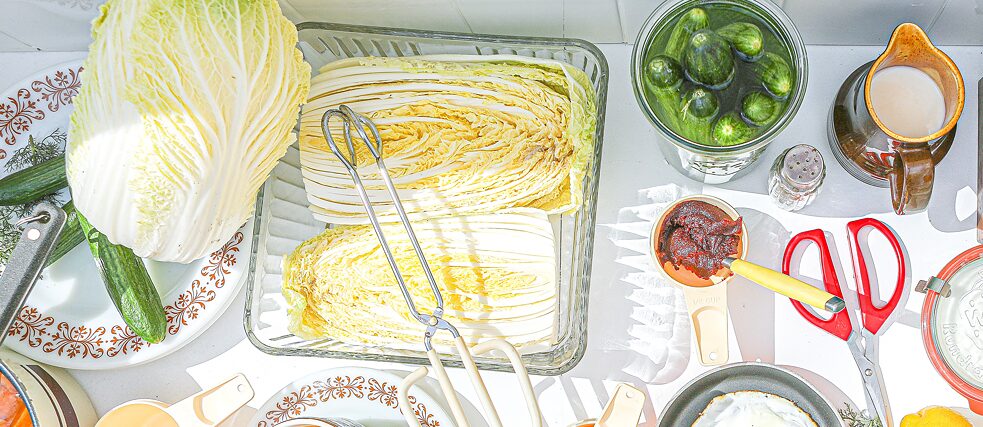You Can’t Rush It
Kimchi
Kimchi is a Korean preparation of fermented cabbage that results in a spicy, crunchy, and tart delight. Like other cabbage dishes, it originated as a means of enjoying vegetables when they are out of season.
What is the origin of kimchi?
Like so many dishes, kimchi is a way of preserving vegetables beyond the summer months. Korean farmers invented it so that they could enjoy delicate Chinese (or napa) cabbage even in the winter. Fermentation is particularly well suited for preserving the cabbage and all its vitamins even when the next harvest is a long time away.My search for kimchi
Kimchi, for me, means patience. Acquiring the ingredients takes effort and waiting since not all the ingredients are readily available near me. I usually need to make a detour to the Asian supermarket and make some purchases on the internet to get everything together. When I first set out to prepare fermented cabbage, I was looking not only for the best recipe but also for the best instructions and explanations. I didn’t want to just be shown the steps, but also to understand the reasons behind them. I found what I was looking for with the YouTuber Maangchi. She has a great way of taking her audience along and explaining why and when you need to be patient; you can’t rush kimchi. After I was done with my first batch, I enthusiastically watched almost all the videos on her channel because it’s just delightful to watch her cook.For kimchi, the production process requires a great deal of patience. You must not only salt the Chinese cabbage thoroughly; the subsequent steeping and fermentation processes, important steps that give kimchi its characteristic tart flavor, take even more time.
When you invest so much time in a dish, it tastes all the better for the long wait. The whole family sees the jar in the kitchen, and all ask repeatedly when they can finally try it. When that time finally comes, there’s nothing better than opening a jar and announcing, “The kimchi is ready!” In our family, it’s a moment to be celebrated. A dinner served with kimchi is a very special one.
Ingredients
- 2 heads (approximately 2.2 kiloggrams/4.8 pounds) of Chinese cabbage
- 0.5 cups of salt
- 2 cups of water
- 2 tablespoons of glutinous rice flour
- 2 tablespoons of sugar
- 2 bulbs (approximately 20 cloves) of garlic
- 1 white onion
- 1 piece of ginger (about 2 centimeters/0.75 inches)
- 0.75 cups of fish sauce
- 1.5 cups of gochugaru (Korean hot chili flakes)
- 2 carrots
- 1 bunch of spring onions
- 0.5 bunches of Asian chives (buchu) or chives
Directions
There are countless versions and recipes for preparing kimchi, and every Korean family passes down its own unique tradition. I, therefore, don’t claim originality and prefer to call the dish below fermented cabbage inspired by a recipe by Maangchi.Remove the wilted leaves from the Chinese cabbage. Cut the cabbage heads halfway through from the bottom, then take the cabbage in both hands, and carefully tear the head in half. With this trick, the upper parts of the leaves remain beautifully fringed.
Now, make another cut in each cabbage from the bottom halfway through, but so that the resulting cabbage quarters stay together at the top. Rinse the cabbage halves once, and let the water run over the cut surfaces. Then only shake them off a little. Some liquid may remain between the leaves.
Now, salt the cabbage. Carefully sprinkle salt between each leaf until you’ve used the entire amount. This takes a little time, but ensures that nice crunchy kimchi! Put the salted cabbage halves in a bowl, and let them steep in the water for two hours. While steeping, turn the cabbage halves every 30 minutes so that it all draws moisture evenly. While the cabbage is steeping, the kimchi paste can be prepared. Be sure to allow some time for cooling.
In a generously sized pot, mix the water with the glutinous rice flour, and bring it to a boil. While the liquid is thickening, stir in the sugar to dissolve it. Remove the pot from the heat, and let the paste cool completely to room temperature.
Peel the carrots, and cut them into narrow strips. Peel the onions, cut them in half, and slice them lengthwise into wide strips.
Wash the chives, pat dry, and cut into fine rings. Clean the spring onions, and cut them into rings too. Peel and grate the ginger. Now, combine everything with the fish sauce and spices, and add it to the cooled rice flour paste. Taste it to check if the paste is spicy enough for you. If not, add some more gochugaru.
Fill a large bowl with cold water, put the Chinese cabbage in it, carefully fan out the leaves, and rinse the salt off. Repeat this process three times so that there is no salt left in the cabbage.
Grasping them from the cut sections, tear each of the two halves of cabbage into quarters. Spread all the kimchi paste between each leaf with your fingers. Make sure that all the cabbage is completely covered with the spicy paste.
Feel free to taste a portion: Fresh, unfermented kimchi tastes like a spicy salad. Fantastic!
Finally, put the cabbage quarters in a tightly sealed container. A glass casserole dish with a lid, a larger plastic jar, or even a canning jar with a screw-on lid is suitable for this. It doesn’t really matter what kind of container you use as long as it can be sealed tightly. Layer the cabbage quarters in it, and press them down so that no gaps or air bubbles remain, where mold can develop.
Now, seal the container tightly, and let it ferment at room temperature. Thanks to the rice flour, you can already begin to observe the fermentation process after one or two days. Every now and then, open the container, and press the fermenting material further down so that the cabbage is submerged in the developing juice. If you notice that the cabbage is not submerged, simply keep pressing it down.
After two days, you can test to see if the fermentation is to your liking. If the kimchi is still not tart enough for you, the fermentation time can be extended up to a week. Personally, I think it’s perfect after just two days!
Then, put the container in the refrigerator. The cold slows down the fermentation, and the kimchi can be gradually consumed. According to Maangchi, it keeps “almost forever” this way, but it will probably be eaten up long before that!







